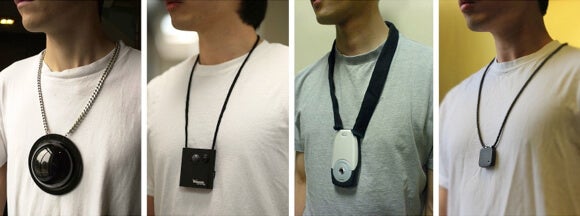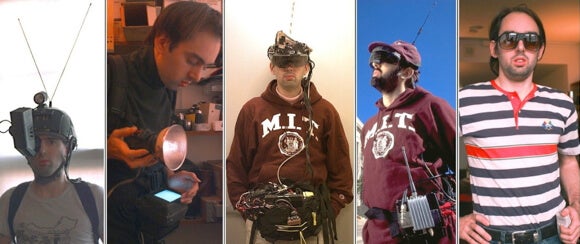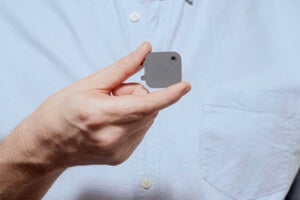Lifelogging Gear Is Small, Cheap, and Powerful, So Like It Or Not, You’re Going To Be Recorded
I’m sitting in a café with some forty other people. Most us are working on a laptop, and each laptop has a camera. In fact, many of my café coworkers also have a smartphone. These devices have a camera. Most have two. While there’s something like 100+ cameras within twenty feet of me, few of them are likely recording. But a (not-so-new) movement would change that. It’s called lifelogging, and if you have geekish tendencies, you’ve likely heard of it.

Share
I’m sitting in a café with some forty other people. Most are on a laptop, and each laptop has a camera. In fact, many of my café coworkers also have a smartphone. These devices have a camera as well. Many have two.
While there’s something like 100+ cameras within twenty feet of me, few of them are likely recording. But a (not-so-new) movement would change that. It’s called lifelogging, and if you have geekish tendencies, you’ve likely heard of it.
The idea is pretty simple. Life's experiences are fleeting. Sure, we can remember some of them, but our memories are sporadic and unreliable. If we recorded more (or even all) of our lives, we could revisit yesterday to discover where we left the keys, dig up buried memories, and relive lost moments.
Although the concept has a multi-decade history, it’s never really escaped the fringe for obvious reasons. Until the last ten years or so, electronics were too bulky and storage capacities too small and expensive. (See the images above and below.)
More recently, however, driven by relentless competition and one-upmanship in smartphones, nearly every component crucial to lifelogging—cameras, digital storage, GPS—has become smaller, cheaper, and more powerful. You can now fit a camera and an 8 GB hard drive on a device the size of a tie clip.

The evolution of Steve Mann, an early proponent of lifelogging, demonstrates the dramatic progress in mobile computing from 1980 through 2013. (Top of the page and above.)
So, as the technical limitations vanish, will lifelogging prove popular or is it still too much for most people? In the last year, we’ve seen interest in the tech community.
The Memoto Kickstarter, for example, earned a viral $550,000. The device, commercially released as the Narrative Clip, is an unassuming $279 square plastic camera that clips onto your shirt or bag. Unless it’s in a pocket or flipped over on its face, the Narrative Clip automatically takes a picture every 30 seconds. Assuming an average 10-hour day, that equates to 1,200 pics a day, 8,400 a week, 33,000 a month, and 400,000 a year.
This barrage of imagery is stored temporarily on the device—up to 8 GB—and may then be transferred to a hard drive. Of course, lifelogging takes significant space (over a terabyte a year), and the thousands of pictures are mostly useless unless you can sort them.
For $9/month (and a free first year), Narrative offers storage and sorting.
Users upload their photos to a cloud system. The software sorts the photos into buckets by time period and chooses the best photo from each bucket. You can then review your day or week by scrolling through all the “best” photos on the Narrative app on an iPhone or iPad and dive into any you’d like to review in greater depth.
We’re talking a lot of photos of mostly banal moments.
But like a hidden camera filming wildlife when humans aren't about, a lifelogging device might catch a moment (or more) when there isn't a posed, frozen grin in sight. And this may be the central selling point of devices like the Narrative Clip.
No discussion of the benefits of such technology, however, is complete without its counterpoint. Like it or not, many folks are frankly uncomfortable at the thought of ubiquitous, continuously rolling cameras. Google Glass is hard to miss. But a small plastic square on somebody's shirt can easily blend in.
Be Part of the Future
Sign up to receive top stories about groundbreaking technologies and visionary thinkers from SingularityHub.


Narrative has a section dedicated to etiquette. Like, for example, when you're in the bathroom, kindly put the device in your pocket; respect "no photograph" zones when indicated; and don't take another person's photo when they ask you not to.
Such rules are, of course, on the honor code, and they're bound to be broken as personal beliefs inform behavior as much as unenforceable universal codes.
And you have to consider that a single corporation is storing millions of photos. Sure, it's in their interest to guard their customers privacy, but security has holes and certain outside parties, like intelligence agencies, can strong-arm firms to grant access.
While the user knows of and permits such storage, many photographs will inevitably be of friends and strangers, many of whom may not know their image has been captured.
For now, anonymity is maintained because faces aren't recognized or tagged, but algorithms are fast learning to look at and understand pictures. And a photo hoard complete with GPS tags, time stamps, and faces may prove a treasure trove of information for well-intending and malevolent actors.
All that, of course, assumes lifelogging grows in popularity, like, for example, social networking has in recent years. The two, both involving the continuous documentation of personal lives, are not so different. But for now, at least, that seems unlikely.
While it's tempting to equate Kickstarter popularity to wider demand, most Kickstarters belong to a niche demographic—technophiles and early adopters. Lifelogging seems likely to remain a growing but still fringe hobby in the near future.
Wider popularity will require not just smaller technology, but better technology, with a more compelling reason to use it. And, agree or not, the culture of worry surrounding surveillance devices may restrain adoption somewhat.
But in the longer term? Future generations will evolve their own conceptions of technological costs, benefits, and the very definition of privacy. Add changing attitudes to even more powerful devices (continuous 24/7 video and cloud connection? immersive playback?) and lifelogging might get legs in a big way.
Image Credit: Steve Mann/Wikimedia Commons; ashlita marie/Flickr
Jason is editorial director at SingularityHub. He researched and wrote about finance and economics before moving on to science and technology. He's curious about pretty much everything, but especially loves learning about and sharing big ideas and advances in artificial intelligence, computing, robotics, biotech, neuroscience, and space.
Related Articles

This Portable Wind Turbine Is the Size of a Water Bottle and Charges Devices in Under an Hour

Mojo Vision’s New Contact Lens Brings Seamless Augmented Reality a Step Closer
The Weird, the Wacky, the Just Plain Cool: Best of CES 2020
What we’re reading



